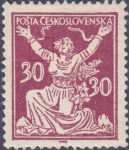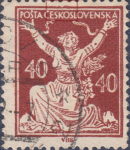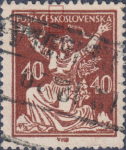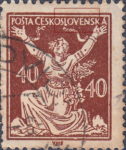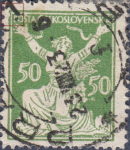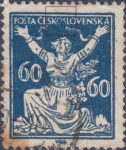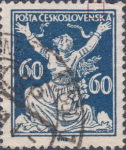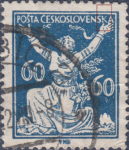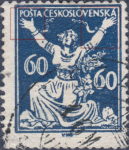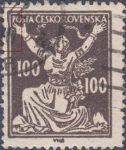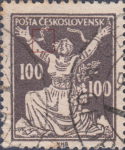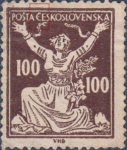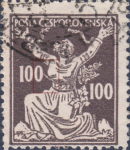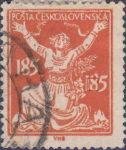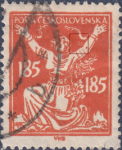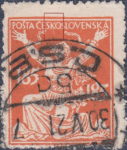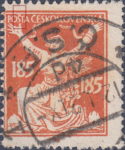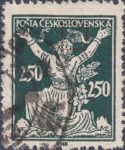Czechoslovakia – the Liberated Republic
Introduction
The symbolism
The design was created by Vratislav Hugo Brunner already in 1919 for the 2nd Stamps Competition for the 1st Czechoslovak Republic. It was awarded the 1st prize but despite this evaluation, the proposal was not accepted for implementation at the time. The author used a slightly modified design to win the third competition.
The drawing represents an allegorical figure tearing shackles, behind the figure is a linden tree (symbol of the Slavs). It is a symbolic representation of the liberation of the homeland. In the background, there are Říp and Kriváň mountains. (According to legend, the first Czechs settled at Říp mountain, while Kriváň was a major symbol of Slovak ethnic and national revival). Initials of the author (VHB) were placed below the bottom edge of the image.
The print
The stamps were printed in letterpress by the České grafické Unie in Prague. In total, 11 values were printed, three of them (40, 50 and 60 h) also in the head-to-tail setting. The three values for booklet issues were line perforated 13¾.
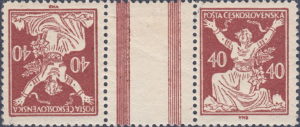 |
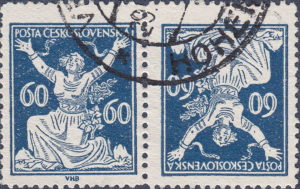 |
| The head-to-tail setting, with and without a gutter. | |
Types
The original stamps of 40 h were without the white spot (the tenth leaf). Later on, of unknown reasons, another printing plate was produced out of the 30 h stamp design. As the bottom of the numeral 3 remained insufficiently covered, the white end tip of the numeral was transmitted to the new 40 h plate.
Interestingly, at the later stage of printing, yet another plate was produced. This time, the “10th leaf defect” was detected and corrected on 99 stamps in a pane, but remained in a single field (96th, above counter mark 24,-). The result is a pane where 99 pieces were of type I and only one stamp of type II. Since the number of stamps, printed with this plate was relatively smaller, the combination of both types (se-tenant), both in unused and used state is very rare.
| TYPES | ||
|---|---|---|
| 40 h | ||
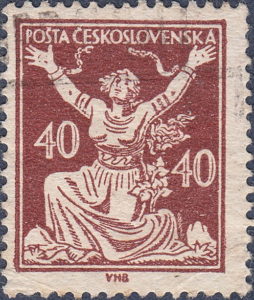 |
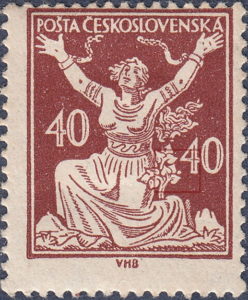 |
Type I:
Type II:
|
| Type I | Type II | |
Constant varieties
| CONSTANT VARIETIES | |||
|---|---|---|---|
| 30 h | |||
| I
|
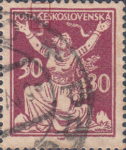 |
Colored circle in letter Č in ČESKOSLOVENSKÁ. | |
| Field №: ? | Pane: N/A | ||
| Other nomenclatures: I/3 | |||
| Notes: – | |||
| Value €: 5 | |||
| II | 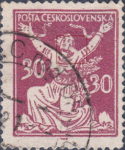 |
Large white spot on allegory’s neck. | |
| Field №: 14 | Pane: N/A | ||
| Other nomenclatures: II/2 | |||
| Notes: – | |||
| Value €: 5 | |||
| 50 h | |||
| I | 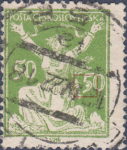 |
Big white dot on the left side of the right-sided numeral 5. | |
| Field №: ? | Pane: N/A | ||
| Other nomenclatures: IIIP/1 | |||
| Notes: – | |||
| Value €: 5 | |||
| 60 h | |||
| I | 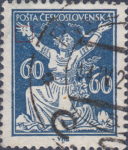 |
White dot on allegory’s left hand. | |
| Field №: 75 | Pane: N/A | ||
| Other nomenclatures: II/1 | |||
| Notes: – | |||
| Value €: 4,5 | |||
| 100 h | |||
| I | 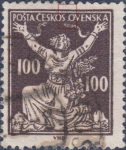 |
Letter L in ČESKOSLOVENSKÁ missing. | |
| Field №: ? | Pane: N/A | ||
| Other nomenclatures: I/5 | |||
| Notes: – | |||
| Value €: 5 | |||
| II | 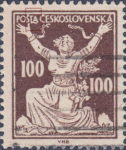 |
Letters T and A in POŠTA connected by a curved line at the bottom. | |
| Field №: 17 | Pane: N/A | ||
| Other nomenclatures: I/1 | |||
| Notes: another example. | |||
| Value €: 5 | |||
| III | 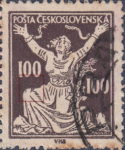 |
Large incision in allegory’s leg. | |
| Field №: ? | Pane: N/A | ||
| Other nomenclatures: IV/2 | |||
| Notes: – | |||
| Value €: 4,5 | |||
| 185 h | |||
| I | 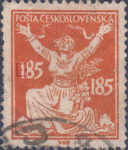 |
Incision in the left-sided numeral 1. | |
| Field №: ? | Pane: N/A | ||
| Other nomenclatures: IIIL/1 | |||
| Notes: – | |||
| Value €: 4,5 | |||
| II | 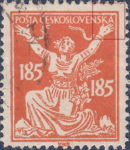 |
Thin white line in the top right corner, over letter K in ČESKOSLOVENSKÁ and right palm. | |
| Field №: 10 | Pane: N/A | ||
| Other nomenclatures: I/4 | |||
| Notes: – | |||
| Value €: 4,5 | |||
| 250 h | |||
| I | 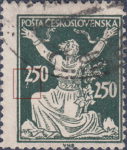 |
Vertical lines below the left-sided numeral 2. | |
| Field №: ? | Pane: N/A | ||
| Other nomenclatures: IIIL/1 | |||
| Notes: – | |||
| Value €: 4,5 | |||
Unlisted varieties
References
Bibliography
-
- Jan Karásek, Antonin Michele, Bohuslav Svoboda: Monografie Češkoslovenských Známek, Díl II. – Legionářské 1919 – hospodářstvi a věda 1923, Prague 1971.
- Michel Osteuropa 2005/2006, Schwaneberger Verlag GmbH, ISBN 3-87858-684-1
Contributors
Some of the images on this page were contributed by:
- here could be a link to your store

